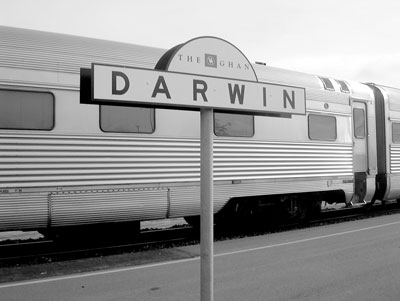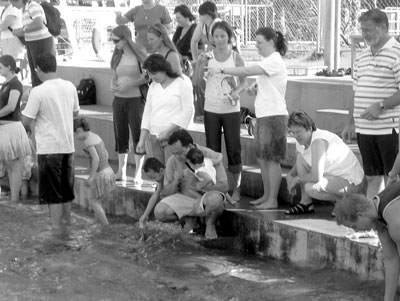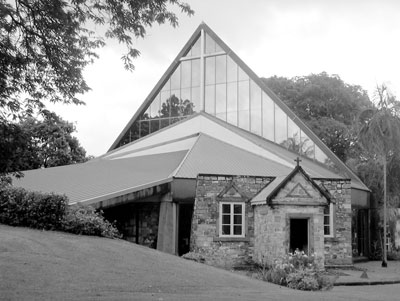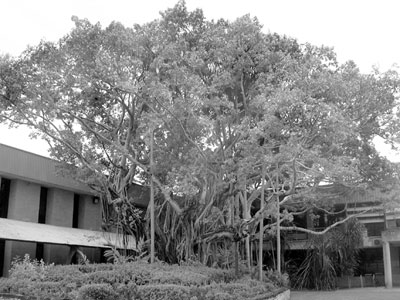New Ghan: out of Darwin
(First of three parts on Australia, jump to part 1, part 2, part 3)
On March 20, 2006, the Ghan pushed during the night from Australia’s wet, green tropics into the hard, red, waterless wasteland known as the “Outback” on its premier Monday southbound trip of the season.
Our train, the Ghan (rhymes with “can,” as in Afghanistan), had left Darwin along new, smooth rails that, since February 2004, have connected the Northern Territory on the Timor Sea coast to coast with the waters of Gulf St. Vincent in the state of South Australia.
During the dry season (April to November), when visitors flock to Darwin, there are two Ghan departures weekly. During the wet season, a single Ghan per week leaves Darwin.
Darwin’s lock on history stems from World War Two, when the city was leveled by Japanese bombers, all civilians were evacuated and the city became a military garrison and submarine base bristling with antiaircraft guns.
The city suffered further when, in December 1974, Cyclone Tracy struck, devastating the city, which was later rebuilt in a hasty, not-very-well-unified architectural style, more haphazard than harmonious.
What Darwin lacks in architectural charm, it makes up for in vitality and energy — the average age of the residents is 28. In addition to being government headquarters, Darwin is a youth and family center and backpackers’ headquarters with outfitters in every block.
The Top End
The pleasing tropical territorial capital (pop. 100,000) is ringed with trails and bicycle tracks leading to sandy beaches, mangroves, monsoon forests, cliffs, rock platforms and an impressive coastline. Stringy trees typical of the tropics beautify the parks. Ramrod-straight palms look as uncomfortable as unwelcome tourists.
On the bluffs overlooking the seafront you can stroll through broad, green, tree--covered Bicentennial Park, which is marked with countless monuments and historic plaques recalling the growth of Darwin and especially its WWII defensive importance and the disastrous bombing raids of the war.
Adjacent to Bicentennial Park, Aquascene is one of Darwin’s unique attractions. During high tide, ravenous fish nibble and snag bread crusts from the hands of visitors and jump for tossed crusts like groups of baseball fans leaping in unison for a Barry Bonds home run ball. Adult admission costs Aus$7 (near US$5).
You will also enjoy visiting the crocodile farm 25 miles south of Darwin to watch jumping crocodiles swim in for lunch (do not feed by hand) as well as Crocodylus, 15 minutes from Darwin city (feeding times at noon, 2 and 3:30 p.m.), excursions to Litchfield and Kakadu national parks, and world-class fishing for barramundi and other tropical fish.
Darwin Station
Darwin train station was built to handle freight transportation to the port on a peninsula across the bay from Darwin city. The passenger terminus was an afterthought, so its location away from the city is unfortunate. It is farther from the city than the airport, so it is wise to use the bus connections provided free to Gold Kangaroo (first--class) passengers to and from all of the major hotel pickup points. Red Kangaroo (second-class) passengers may take a coach costing Aus$10.
Outside Darwin Station you see the diesel locomotive attached to the head of your Ghan and a string of stainless-steel, 30-year-old, often refurbished “Budd” cars (built by Commonwealth Engineering, Granville, New South Wales, under license from the Budd Company, Philadelphia, PA, USA) stretching into the distance. Buses shuttle from the terminal to the train because many passengers are unable to walk the nearly half mile.
The Ghan’s consist (makeup) includes Gold Kangaroo sleeping cars, dining rooms and lounge carriages as well as very comfortable “Red Kangaroo” sitting carriages.
All Gold Kangaroo passengers take their meals in a dining car (there are two seatings). Vending machines in the Red Kangaroo carriages supply those passengers.
Smokers take last puffs on their cigarettes (the Ghan is a nonsmoking train by law) and toss them away at 9:45 a.m. Monday (Wednesday departures are 15 minutes later) before settling into their cabins, which are tight, each with two bunk beds. Be sure to check your luggage before boarding.
At 10:30 a.m. the barman opens the bar, and passengers, mostly gregarious Australians, migrate to the lounge to exchange hellos and where-are-you-froms? A background commentary murmurs from the sound system.
Waiters serve Bushman’s lunch (first seating) at 11 a.m., while Swagman’s lunch follows at 12:15 p.m., and during seatings the train captain takes reservations for passengers who wish to take one of the optional tours at Katherine, our nearly 5-hour halt at 1:40 p.m.
Katherine
The Katherine region is a vast network of rivers, escarpments and gorges that weave through sprawling plains of cattle stations, national parks and reserves. The township of Katherine (pop. 10,000) is the hub of the region.
Katherine’s star attraction is Nitmiluk National Park, 20 miles from town. Here the Katherine River squeezes through towering sandstone cliffs to form the Katherine Gorge.
Stewards unlock doors at 1:40 p.m. and passengers flock, under glowering skies and the first drops of a wet-season shower, onto the waiting, white, numbered Ghan buses.
Katherine tour options include river and helicopter cruises through the Katherine Gorge as well as visits to Katherine city. Everyone bragged about visiting the gorges, whether by air or river. They reported that the Outback town was not worth seeing.
With everyone back aboard and exchanging anecdotes, the Ghan departs at 6:20 p.m., the barman opens the bar, and waiters call the Sunset dinner (first seating). Shortly thereafter, late diners join a champagne reception and orientation in the lounge. The second dinner seating (Moonlight dinner) follows while the diners from the first seating gather in the lounge for a second reception.
Porters have made up bunks before passengers return to their cabins, and most passengers settle in and sleep like babies. The overnight from Darwin is smooth on the 2-year-old rails, but the following night’s ride from Alice to Adelaide is promised to be turbulent.
On my trip, at 1 a.m. the Ghan stopped at Tenant Creek to allow a Red Kangaroo passenger to debark. The young man, whom I had met in Katherine, was from Switzerland. In the Swiss army, he had been in a bicycle unit. He told me that he had once visited Australia with his parents and sister and liked Australia so much that he had sworn to return. In the pitch blackness of 1 a.m. he was on his way to a camping place with backpack and the bicycle he had brought along.
Coming next month
In August aboard the Ghan, we’ll spend three hours in Alice Springs for lunch and then cross the Outback to Adelaide, the capital of South Australia.
I thank NT Tourism (phone 636-366-8162 or visit www.australiasoutback.com) for providing accommodation at the Crowne Plaza Hotel (phone 61-8-8982000, www.ichotelsgroup.com), which is conveniently located in Darwin’s city center.
Air and train transportation were provided by the South Australian Tourism Commission (phone 888/768-8428 or visit www.southoz.com). The Qantas flight from Sydney’s International Terminal to Darwin was as good as it gets. In April 2006, Qantas resumed nonstop flights between San Francisco and Sydney, with seasonal connections between San Francisco and Vancouver.
—All Aboard! is written by Jay Brunhouse




